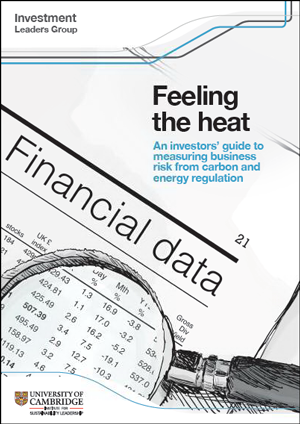May 2016 – The COP 21 climate agreement indicates a growing global consensus for action on climate change. In response, this research report assesses the impact of future carbon- and energy-related regulation on the most sensitive industries and geographies at a company level.
 Context
Context
The COP 21 climate agreement indicates a growing global consensus for action on climate change. In response, this research report assesses the impact of future carbon- and energy-related regulation on the most sensitive industries and geographies at a company level.
About the report
Developed by the Investment Leaders Group (ILG), a network of 10 leading investment managers and asset owners, it includes a model that quantifies the impact of potential climate and energy regulation on company profitability. The model aims to improve stock picking and empowers investors to engage with companies on actions they can take to make them ‘future proof’.
The report covers three high-risk sectors (i.e. electric utilities, oil refining and natural gas) in five key countries, namely the UK, Spain, Germany, Canada (Alberta province) and the US (California). The modeling demonstrates that the financial risk can be substantial. With the help of an analytical tool, investors can begin anticipating the financial impact of future climate-related policy within their models and investment decisions.
The purpose of the model
• To help the investment industry price in potential future risks associated with energy and carbon regulation, and encourage mitigating strategies, allowing investors to pick stocks based on their relative carbon and energy regulation risk.
• To provide outputs that can be integrated into existing valuation techniques, providing transparency on the measures required for companies to reduce the impacts on profitability associated with climate-related regulations.
• To aid companies seeking to understand their ability to respond to energy and carbon regulation, and where they should prioritise their efforts.
The key characteristics of the model
• It captures both energy- and carbon-related regulation as governments can use mechanisms beyond carbon pricing to introduce climate-positive changes in the real economy.
• It defines two regulatory scenarios for 2020, allowing for the straightforward interpretation, communication and validation of results.
• It is dynamic in that it captures an individual company’s potential for mitigating regulatory risk. It thus provides a risk assessment arising from the chosen regulatory scenario before and after any corporate action.
Key findings
The research in the report reveals significant effects of climate and energy regulation on company profitability at a national level. It also highlights significant differences between individual companies in the same sectors and geographies – especially once their response potential is included. The findings reveal that carbon and energy regulation can impact companies’ margins; companies’ risk mitigation activities matter; and energy and carbon risk assessments can facilitate stock-picking.
Citing this report
Please refer to this report as University of Cambridge Institute for Sustainability Leadership (CISL). (2016, May). Feeling the heat: An investors’ guide to measuring business risk from carbon and energy regulation. Cambridge, UK: Cambridge Institute for Sustainability Leadership.



